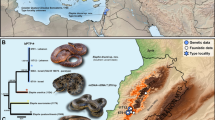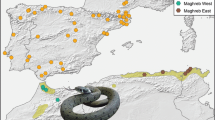Abstract
The Australian elapid snakeHoplocephalus stephensii (Stephens' BandedSnake) is patchily distributed in disjunctforest remnants in eastern Australia and islisted as threatened in both states in which itoccurs (Qld and NSW). Here we focus on thephylogeography of H. stephensii toaddress (1) the genetic distinctiveness of thistaxon within its genus and (2) the level ofgenetic diversity present within and betweendisjunct populations from throughout thespecies' range. We sequenced an approximately900 base pair DNA fragment of the mitochondrialgenome that includes half of the ND4 gene andthree tRNA genes. We obtained sequence datafrom 15 H. stephensii individuals drawnfrom four populations, plus representatives ofthe other Hoplocephalus species.Phylogenetic analyses of the data produced asingle fully resolved tree. The two coastaltaxa (H. bungaroides and H. stephensii)are very closely related (2.6–3.1% sequencedivergence) whereas the inland taxon H.bitorquatus is more distantly related to theother two (7.6% vs H. bungaroides;7.8–8.3% vs H. stephensii). Geneticdiversity is low within H. stephensii(nine mitochondrial haplotypes with 1–3haplotypes with only single base pairdifferences within populations). The largestsplit (1.7% sequence divergence) occursbetween the northern population and the threesouthern populations and corresponds to thespecies distribution north and south of theMcPherson Range on the Queensland-New SouthWales border. The three southern populationsdisplay much less molecular divergence (maximumof 0.6% sequence divergence), consistent withthe presence of generally continuous forestthroughout the species' range until Europeaninvasion of Australia 200 years ago, and withradiotelemetric studies that have found highvagility in these arboreal snakes. Thus, onthe basis of genetic distinctiveness we arguethat (1) Hoplocephalus bitorquatus shouldreceive high conservation priority; and (2)managers should treat the Queensland and NSWpopulations of H. stephensi as separateconservation units.
Similar content being viewed by others
References
Arévalo E, Davis SK, Sites J (1994) Mitochondrial DNA sequence divergence and phylogenetic relationships among eight chromosome races of the Sceloporus grammicus complex (Phrynosomatidae) in Central Mexico. Syst. Biol., 43, 387–418.
Benabib M, Kjer KM, Sites JW (1997) Mitochondrial DNA sequence-based phylogeny and the evolution of viviparity in the Sceloporus scalaris group (Reptilia, Squamata). Evolution, 51, 1262–1275.
Bonnet X, Bradshaw D, Shine R, Pearson D (1999) Why do snakes have eyes? The (non-) effect of blindness in island tigersnakes. Behav. Ecol. Sociobiol., 46, 267–272.
Brown WM, George M, Wilson AC (1979) Rapid evolution of animal mitochondrial DNA. Proc. Nat. Acad. Sci. USA, 76, 1967–1971.
Cogger HG (2000) Reptiles and Amphibians of Australia, 6th Edition.Reed Books, Chatswood, Australia.
Cogger HG, Cameron EE, Sadlier RA, Eggler P (1993) The action plan for Australian reptiles. Australian Nature Conservation Agency
Canberra, A.C.T. Covacevich J, Couper PJ, McDonald KR (1998) Reptile diversity at risk in the brigalow belt, Queensland. Mem. Queenlsand Mus., 42, 475–486.
Crisp MD, Linder HP, Weston PH (1995) Cladistic biogeography of plants in Australia and New Guinea: Congruent pattern reveals two endemic tropical tracks. Syst. Biol., 44, 457–473.
Fitzgerald M, Shine R, Lemckert F (2001) A radiotelemetric study of habitat use by the arboreal snake Hoplocephalus stephensii (Elapidae) in eastern Australia. Copeia, in press.
Fitzgerald M (2002) Ecological Studies on a Threatened Australian Snake, Hoplocephalus stephensii. Ph D thesis, University of Sydney, NSW, Australia.
Flannery TF (1994) The Future Eaters. Reed Books, Sydney.
Ford J (1987) Hybrid zones in Australian birds. Emu, 87, 158–178.
Forstner MRJ, Dixon JR, Forstner JM, Davis SK (1998) Apparent hybridization between Cnemidophorus gularis and Cnemidophorus septemvittatus from an area of sympatry in southwest Texas.J. Herpetol., 32, 418–425.
Hutchinson MN (1990) The generic classification of the Australian terrestrial elapid snakes. Mem. Queensland. Mus., 28, 397–405.
James CH, Moritz C (2000) Intraspecific phylogeography in the sedge frog Litoria fallax (Hylidae) indicates pre-Pleistocene vicariance of an open forest species from eastern Australia. Mol. Ecol., 9, 349–385.
Jukes TH, Cantor CR (1969) Evolution of protein molecules. In: Mammalian Protein Metabolism (ed. Munro HN), pp. 21–132. Academic Press, New York.
Keogh JS (1998) Molecular phylogeny of elapid snakes and a consideration of their biogeographic history. Biol. J. Linn. Soc., 63, 177–203.
Keogh JS (1999) Evolutionary implications of hemipenial morphology in the terrestrial Australian elapid snakes. Zool. J. Linn. Soc., 125, 239–278.
Keogh JS, Shine R, Donnellan S (1998) Phylogenetic relationships of terrestrial Australo-Papuan elapid snakes based on cytochrome b and 16S rRNA sequences. Mol Phyl. Evol., 10, 67–81.
Keogh JS, Scott IAW, Scanlon JD (2000) Molecular phylogeny of viviparous Australian elapid snakes: Affinities of ‘Echiopsis’ atriceps (Storr 1980) and ‘Drysdalia’ coronata (Schlegel 1837), with description of a new genus.J. Zool., Lond., 252, 317–326.
Kraus F, Mink DG, Brown WM (1996) Crotaline intergeneric relationships based on mitochondrial DNA sequence data. Copeia, 1996, 763–773.
Lee MSY (1997) Phylogenetic relationships among Australian elapid snakes: The soft anatomical data reconsidered. Herpetol. J., 7, 93–102.
Lunney D, Hand S, Reed P, Butcher D (eds.) (1994) Future of the Fauna of Western New South Wales. Royal Zoological Society of New South Wales, Sydney.
Lunney D, Curtin A, Ayers D, Cogger HG, Dickman CR, Maitz W, Law B, Fisher D (2000) The Threatened and Non-Threatened Native Vertebrate Fauna of New South Wales: Status and Ecological Attributes. New South Wales National Parks and Wildlife Service, Hurstville, NSW.
Mengden GA (1983) The taxonomy of Australian elapid snakes, a review. Rec. Aust. Mus., 35, 195–222.
Mengden GA (1985) Australian elapid phylogeny: A summary of the chromosomal and electrophoretic data. In: Biology of Australasian Frogs and Reptiles. (eds. Grigg G, Shine R, Ehmann H), pp. 185–192. Surrey Beatty and Sons, Sydney.
Moritz C (1994) Applications of mitochondrial DNA analysis in conservation–a critical review. Mol. Ecol., 3, 401–411.
Moritz C (1995) Uses of molecular phylogenies for conservation. Phil. Tras. R. Soc. Lond, Ser. B., 349, 113–118.
Moritz C, Faith DP (1998) Comparative Phylogeography and the identification of genetically divergent areas for conservation. Mol. Ecol., 7, 419–429.
Posada D, Crandall KA (1998) Modeltest: Testing the model of DNA substitution. Bioinformatics, 14, 817–818.
Reed RN, Shine R (2001) Lying in wait for extinction? Ecological correlates of conservation status among Australian elapid snakes. Cons. Biol., in press.
Rodda GH, Fritts TH, McCoid MJ (1999) An overview of the biology of the Brown Treesnake (Boiga irregularis), a costly introduced pest on Pacific Islands. In: Problem Snake Management: The Habu and the Brown Treesnake (eds. Rodda GH, Sawai Y, Chiszar D, Tanaka H), pp. 44–80. Comstock Publ. Assoc.
Schwaner, TD (1985) Population structure of black tiger snakes, Notechis ater niger, on offshore islands of South Australia. In: Biology of Australasian Frogs and Reptiles (eds. Grigg G, Shine R, Ehmann H), pp. 35–46. Surrey Beatty and Sons, Sydney.
Schwaner TD, Baverstock PR, Dessauer HC, Mengden GA (1985) Immunological evidence for the phylogenetic relationships of Australian elapid snakes. In: Biology of Australasian Frogs and Reptiles (eds. Grigg G, Shine R, Ehmann H), pp. 77–184. Surrey Beatty and Sons, Sydney.
Scott IAW, Keogh JS (2000) Conservation genetics of the endangered grassland earless dragon Tympanocryptis pinguicolla (Reptilia: Agamidae) in Southeastern Australia. Cons. Gen., 1, 357–363.
Shine R (1977) Habitats, diets, and sympatry in snakes: A study from Australia. Canadian J. Zool., 55, 1118–1128.
Shine R (1983) Arboreality in snakes: Ecology of the Australian elapid genus Hoplocephalus. Copeia, 1983, 198–205.
Shine R (1987) Ecological comparisons of island and mainland populations of Australian tigersnakes (Notechis: Elapidae). Herpetologica, 43, 233–240.
Shine R (1991) Australian Snakes. A Natural History. A.H. and A.W. Reed, Sydney.
Shine R, Charles N (1982) Ecology of the Australian elapid snake Tropidechis carinatus. J. Herpetol., 16, 383–387.
Shine R, Webb JK, Fitzgerald M, Sumner J (1998) The impact of bush-rock removal on an endangered snake species, Hoplocephalus bungaroides (Serpentes, Elapidae). Wildlife Res., 25, 285–295.
Swofford DL (2000) PAUP?. Phylogenetic Analysis Using Parsimony (?and Other Methods). Version 4. Sinauer Associates, Sunderland, Massachusetts.
Templeton AR (1983) Phylogenetic inference from restriction endonuclease cleavage site maps with particular reference to the evolution of humans and the apes. Evolution, 37, 221–244.
Wallach V (1985) A cladistic analysis of the terrestrial Australian Elapidae. In: Biology of the Australasian Frogs and Reptiles (eds. Grigg G, Shine R, Ehmann H), pp. 223–253. Surrey Beatty and Sons, Sydney.
Webb JK, Shine R (1997a) A field study of spatial ecology and movements of a threatened snake species, Hoplocephalus bungaroides. Biol. Cons., 82, 203–217.
Webb JK, Shine R (1997b) Out on a limb: Conservation implications of tree-hollow use by a threatened snake species (Hoplocephalus bungaroides: Serpentes, Elapidae). Biol. Cons., 81, 21–33.
Webb JK, Shine R (1998a) Thermoregulation by a nocturnal elapid snake (Hoplocephalus bungaroides) in Southeastern Australia. Physiol. Zool., 71, 680–692.
Webb JK, Shine R (1998b) Using thermal ecology to predict retreatsite selection by an endangered snake species. Biol. Cons., 86, 233–242.
Webb JK, Shine R (1998c) Ecological characteristics of a threatened snake species, Hoplocephalus bungaroides (Serpentes, Elapidae). Anim. Cons., 1, 185–193.
Webb JK, Shine R (2000) Paving the way for habitat restoration: Can artificial rocks restore degraded habitats of endangered reptiles? Biol. Cons., 92, 93–99.
Wilson AC, Cann RL, Carr SM, George MJr, Gyllensten UB, Helm-Bychowski K, Higuchi RC, Palumbi SR, Prager EM, Sage RD, Stoneking M (1985) Mitochondrial DNA and two perspectives on evolutionary genetics. Biol. J. Linn. Soc., 26, 375–400.
Worrell E (1958) Song of the Snake. Angus and Robertson, Sydney.
Author information
Authors and Affiliations
Corresponding author
Rights and permissions
About this article
Cite this article
Keogh, S.J., Scott, I.A., Fitzgerald, M. et al. Molecular phylogeny of the Australian venomous snake genus Hoplocephalus (Serpentes, Elapidae) and conservation genetics of the threatened H. stephensii . Conservation Genetics 4, 57–65 (2003). https://doi.org/10.1023/A:1021823423944
Issue Date:
DOI: https://doi.org/10.1023/A:1021823423944




